Lockdown has meant a lot of time contemplating the garden and watching the flowers grow. I tend to have an iPhone in my hand. This year has been spectacular for tulips. They even look like the ones on the packet. We had major losses to urban deer, in spite of putting deer fence right round in January (after last year’s losses), basically because we keep our gates open for deliveries. They hadn’t used that route before because there are usually cars using our road as a rat run, but lockdown has left it largely silent. Silent enough for urban deer to risk pavements in the open.
April and May are the best months in our garden, maybe because the stuff that likes acid soil thrives then. August was pretty barren … until we started on dahlias. That might be another chapter.

This is what urban deer do – they had four clumps like this in one night.

The deer just missed one in this clump.
We now shut the gates from 6 p.m. to 8 a.m. It was that or appeal for friends who like venison to sit up all night with crossbows.

For twenty years we had pots of tulips, and got rid of the bulbs after flowering because all the books say that the cultivated varieties won’t naturalise. For a few years we gave them to a friend who planted them on a bank. Looking at his amazing bank, we thought we should try putting last year’s bulbs in another part of the garden. Last year and the year before, we pulled up the tulip bulbs, kept them dry all summer and planted them in open ground in the autumn. They don’t all survive, but enough do (and urban deer had a lot that should be there)!
Last year’s planted out:

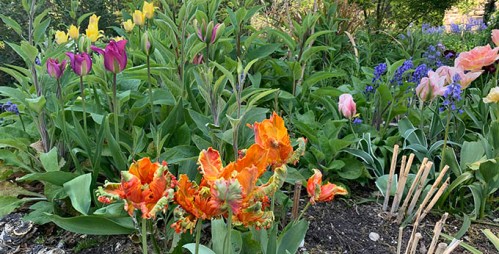


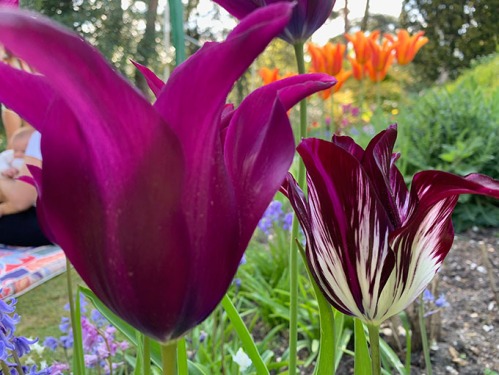





This one must be on its third year
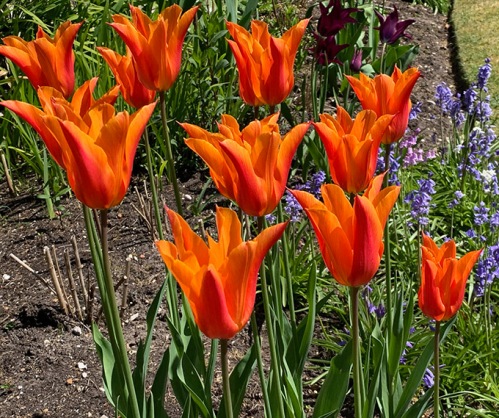

Same tulips. Three weeks later, still going – opposite view of same tulips





Two weeks earlier

The fading is half the effect



These flowered about two weeks later than the ones above them



Same tulips, two weeks later

morning

mid-afternoon

My mum used to say “I don’t like those gaudy colours. Just give me good old red and yellow.”
I also have the feeling that the brighter colours survived planting out much better than the pinks and purples.
We also planted pots:

What were these worth in Holland in the days of tulip fever?
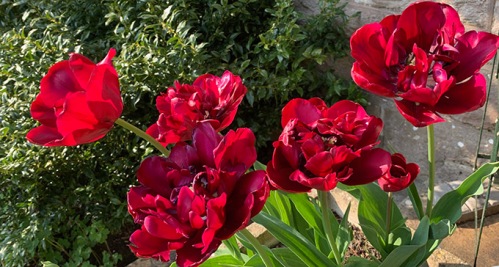


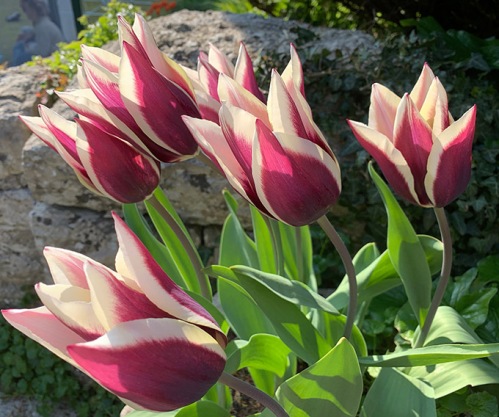






The other bits
Where we differ. Karen loves tiny wild flowers. As a child, she stayed with her grandparents by the canal in Frampton-on-Severn every summer. This is the village that was commemorated by the drawings in The Frampton Flora, done between 1828 and 1851.

The Frampton Flora – illustration (book is 1985 by Richard Mabey)
She remembers the hedgerows- we have one and wild areas.
I like big flashy tulips, towering delphiniums and dahlias. This is reflected in areas of the garden.

Last year we drove out into Dorset to look at bluebell woods. This year we’re just looking at our own. Not a lot of difference.

Karen’s idea of a well-tended lawn

A daily instruction: Don’t step on the cowslips!

Rosemary … and you can cook with it. Since lockdown, we have found that a tomato sauce with rosemary (not from this bush) and wild garlic leaves (we have had four weeks constant supply) works as well as one with basil.

wild garlic, rampant in the garden

Forget-me-nots v tulips? Karen’s choice

weeds are tolerated

Periwinkle. I’m assured this will spread like the bluebells and wild garlic did. We also get lots of tiny wild strawberries later in the year.

knapweed – “but it’s only the cultivated variety” Karen says dismissively.
azaleas
Planted many years ago – the house was built in 1909. They love the soil.



These are only about twenty years old. They take time.

magnolia & viburnum

wisteria

Coming for May …

Lily of the valley will be a carpet in a week

rhodendrums (rhodendra?) will be rampant in a week or so
Leave a comment